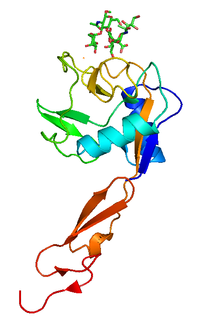
Photo from wikipedia
&NA; Obesity‐induced insulin resistance and metabolic syndrome continue to pose an important public health challenge worldwide as they significantly increase the risk of type 2 diabetes and atherosclerotic cardiovascular disease.… Click to show full abstract
&NA; Obesity‐induced insulin resistance and metabolic syndrome continue to pose an important public health challenge worldwide as they significantly increase the risk of type 2 diabetes and atherosclerotic cardiovascular disease. Advances in the pathophysiologic understanding of this process has identified that chronic inflammation plays a pivotal role. In this regard, given that both animal models and human studies have demonstrated that the interaction of P‐selectin glycoprotein ligand‐1 (PSGL‐1) with P‐selectin is not only critical for normal immune response but also is upregulated in the setting of metabolic syndrome, PSGL‐1/P‐selectin interactions provide a novel target for preventing and treating resultant disease. Current approaches of interfering with PSGL‐1/P‐selectin interactions include targeted antibodies, recombinant immunoglobulins that competitively bind P‐selectin, and synthetic molecular therapies. Experimental models as well as clinical trials assessing the role of these modalities in a variety of diseases have continued to contribute to the understanding of PSGL‐1/P‐selectin interactions and have demonstrated the difficulty in creating clinically relevant therapeutics. Most recently, however, computational simulations have further enhanced our understanding of the structural features of PSGL‐1 and related glycomimetics, which are responsible for high‐affinity selectin interactions. Leveraging these insights for the design of next generation agents has thus led to development of a promising synthetic method for generating PSGL‐1 glycosulfopeptide mimetics for the treatment of metabolic syndrome.
Journal Title: Translational Research
Year Published: 2017
Link to full text (if available)
Share on Social Media: Sign Up to like & get
recommendations!